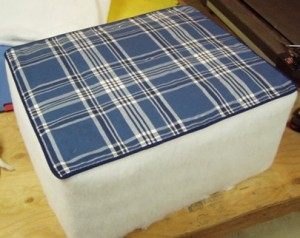 So, in our last episode, we had a padded box and we had stained feet and we had the triangular metal plates screwed into the bottom four corners for the feet. Now for the upholstery, where, as the saying goes, ‘the rubber meets the road’. I really do think this is what scares people away from doing this. I’m breaking this up into two parts because it is so photo heavy.
So, in our last episode, we had a padded box and we had stained feet and we had the triangular metal plates screwed into the bottom four corners for the feet. Now for the upholstery, where, as the saying goes, ‘the rubber meets the road’. I really do think this is what scares people away from doing this. I’m breaking this up into two parts because it is so photo heavy.
Making the cover:
Right up front, I’m going to tell you that I did this in the most bone-headed and inefficient way possible: I made the piece for the top. And then I made the piece to go all the way around the box. And I did not sew them together. This is not how upholstery shops work; they would measure up the top and the sides and make a top and then sew the side piece all the way around to one corner and then pull the whole deal over the box and then handsew the corner closed. And considering the condition of my fingers, I can understand that, but I was so concerned that if I did that, I would end up with one side hanging off a corner that I was very conservative in my approach. As you see from the top photo, I made the top and I bound it with piping all around the edge and I pinned it into place with a gillion pins to make sure it did NOT move. How to make a piece for the top and the sides? Measure and write down the length and width of the fabric for the top and all the way around the sides. Then, walk away and have a cup of tea or coffee or perhaps something stronger, take a moment to consider the essence of the world and the price of cucumbers. Then go back and do the same thing again. And then do it again. And if two of the measurements match, then that’s what you use. Take your fabric and cut using your measurements, cut it out. Make sure you use the selvage (the long ways) as the bottom of the strip to go all the way around the side of the box.
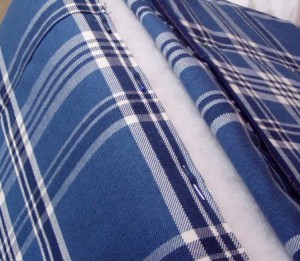 So, the top is on the padding on the top of the box. And, as with the padding, I started the beginning of the side strip NOT at the corner, but over at the center of the side(again, I started on what would be Side 4) and using my handy staple gun (you will learn to love a staple gun with this project), I lined it up to leave an inch hanging over the top and stapled it down. Rolling it over to Side 1, I PINNED it vertically close to the edge and rolled it toward the edge of Side 2, securing the fabric into the padding with pins. When I got to Side 2, I rolled the box over again and secured the fabric with more pins, making sure that I have that 1″ at the top. Now, because I was using plaid fabric, I did have horizontals to work with to keep me on track. I cannot recommend using plaids and strips enough.
So, the top is on the padding on the top of the box. And, as with the padding, I started the beginning of the side strip NOT at the corner, but over at the center of the side(again, I started on what would be Side 4) and using my handy staple gun (you will learn to love a staple gun with this project), I lined it up to leave an inch hanging over the top and stapled it down. Rolling it over to Side 1, I PINNED it vertically close to the edge and rolled it toward the edge of Side 2, securing the fabric into the padding with pins. When I got to Side 2, I rolled the box over again and secured the fabric with more pins, making sure that I have that 1″ at the top. Now, because I was using plaid fabric, I did have horizontals to work with to keep me on track. I cannot recommend using plaids and strips enough.
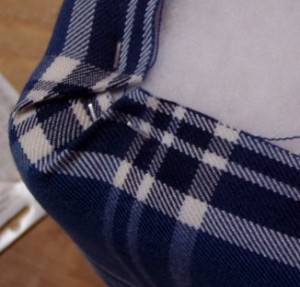 One of the tricky bits on this are the corners and frankly, I went with this sort of corner, where I pulled the fabric right across the corner itself, and I stapled that down and then I folded the other corner bits down. it’s not exactly a mitered corner but it is neat and tidy and it’s all going under the top piece so… no one will ever know (my favorite saying at this point).
One of the tricky bits on this are the corners and frankly, I went with this sort of corner, where I pulled the fabric right across the corner itself, and I stapled that down and then I folded the other corner bits down. it’s not exactly a mitered corner but it is neat and tidy and it’s all going under the top piece so… no one will ever know (my favorite saying at this point).
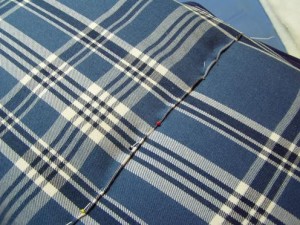 Another tricky bit is the fact that if there is a beginning, there must be an end as well, so I needed to secure the end over the beginning of the fabric strip on the side. Now there is also the additional feature that a) we have padding underneath this and b)we want this to be tight. Tight like a drum, so that when we tuft it with the buttons at the very end, the button will pull in the fabric and padding in this very clever and attractive way. So, what I did was I folded over the end of the fabric strip, secured it with a gillion pins, pulling it tightly as I did so AND MATCHING THE HORIZONTALS IN THE PLAIDS. And then I walked away and had a cup of tea and took a breath and then I went back and I pulled the fabric even tighter (it’s amazing how much stretch upholstery fabric has in it, truly), matched up the plaids, and secured the fabric again and then I basted it down all the way along the fold. And left the pins in too.
Another tricky bit is the fact that if there is a beginning, there must be an end as well, so I needed to secure the end over the beginning of the fabric strip on the side. Now there is also the additional feature that a) we have padding underneath this and b)we want this to be tight. Tight like a drum, so that when we tuft it with the buttons at the very end, the button will pull in the fabric and padding in this very clever and attractive way. So, what I did was I folded over the end of the fabric strip, secured it with a gillion pins, pulling it tightly as I did so AND MATCHING THE HORIZONTALS IN THE PLAIDS. And then I walked away and had a cup of tea and took a breath and then I went back and I pulled the fabric even tighter (it’s amazing how much stretch upholstery fabric has in it, truly), matched up the plaids, and secured the fabric again and then I basted it down all the way along the fold. And left the pins in too.
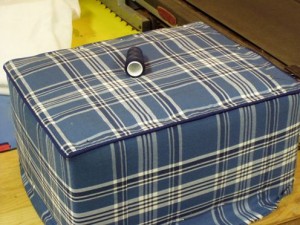 So, now we have the following:
So, now we have the following:
Fabric piece on the top with piping.
Fabric strip all the way around the box and secured, with 1″ hanging over at the top and a whole lot hanging over on the bottom. The 1″ at the top in this photo is basically tucked under the top for the moment.
Now (and I do not have a photo of this, amazingly enough), I carefully lifted the edge of the top piece away and pinned that back all around. Since the rest of it was pinned securely, I didn’t worry about this shifting. I then took my staple gun and pulling the fabric over the top edge, I stapled it down, doing the corners as I described before. Then I re-pinned the top piece over the edge.
 It is now time to introduce you to the instrument of torture I used instead of sewing the top piece to the side piece with my sewing machine. The curved needle in the photo is called an upholstery needle (interestingly enough) and if you don’t have access to an upholstery shop and are going to your local fabric and crafts store, this needle is usually found in a package with a bunch of other large needles that you don’t need but have to buy in order to get the one you want which is this one. It is large and ungainly, does not fit well in the hand, is awkward to use and actually quite painful in that it gives you hand cramps. But it IS the needle that actually works when you are sewing upholstery pieces right on the object you are upholstering. In actuality, I think surgeons use needles to sew up people that look very much like these but I assume they are finer and more efficient than these are, for obvious reasons. And the reason they work really well will be seen in the next photo.
It is now time to introduce you to the instrument of torture I used instead of sewing the top piece to the side piece with my sewing machine. The curved needle in the photo is called an upholstery needle (interestingly enough) and if you don’t have access to an upholstery shop and are going to your local fabric and crafts store, this needle is usually found in a package with a bunch of other large needles that you don’t need but have to buy in order to get the one you want which is this one. It is large and ungainly, does not fit well in the hand, is awkward to use and actually quite painful in that it gives you hand cramps. But it IS the needle that actually works when you are sewing upholstery pieces right on the object you are upholstering. In actuality, I think surgeons use needles to sew up people that look very much like these but I assume they are finer and more efficient than these are, for obvious reasons. And the reason they work really well will be seen in the next photo. 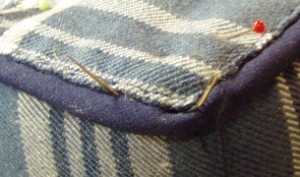 As you can see, what happens is that you stick the needle in and because it is curved, it cuts right through and secures everything and then comes up the other side. It will also come up through your fingers if you are not careful where you put them. So, a word to the wise. Using this method, I sewed around two sides, lost the feeling in my right hand and took a break that lasted a couple of days and then returned and finished the rest.
As you can see, what happens is that you stick the needle in and because it is curved, it cuts right through and secures everything and then comes up the other side. It will also come up through your fingers if you are not careful where you put them. So, a word to the wise. Using this method, I sewed around two sides, lost the feeling in my right hand and took a break that lasted a couple of days and then returned and finished the rest.
Then, I tackled that last seam, which was where the beginning and the end came together. 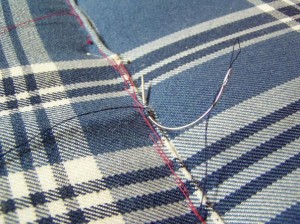 Again, I did not take any chances, and carefully sewed that seam from bottom to top, taking as small stitches as I could. THEN I removed the pins to see if anything was stretching and went over those areas again with the needle to secure them, and THEN I removed the red basting stitches.
Again, I did not take any chances, and carefully sewed that seam from bottom to top, taking as small stitches as I could. THEN I removed the pins to see if anything was stretching and went over those areas again with the needle to secure them, and THEN I removed the red basting stitches.
So, now we have a padded box with upholstery fabric on the top which is secured to the upholstery fabric running all the way around the box. The next bit will finish off the bottom, the tufting, and the feet.
